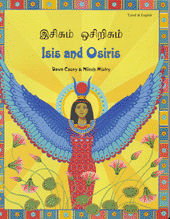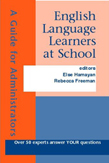
|
|
|
In
This Issue:
• Feature Article:
What is Bilingualism Worth?
• Language Lizard Update:
Celebrating the Bilingual Child Month
• Product Review:
Isis and Osiris
• *Subscriber Special Offer*:
Discount on popular Myths and Legends
• Lizard Recommends: Book to support education of English Language Learners
Please add [email protected] to
your address book or whitelist in your email program so that
you receive all future issues!
To change your subscription, see link at end of email.
If this issue has been forwarded to you, please sign up here
to receive our e-newsletter.
|
|

|
Language Lizard
Update
Dear Reader:
We’re all beginning to think about ghosts and goblins, but did you know that October is also Celebrating the Bilingual Child Month?
This is a great time for families to celebrate their heritage – reading books in multiple languages, eating foods from the “home country” and learning about important traditions. Teachers can also use this month to encourage early language learning and an understanding of other cultures. Bilingual children are huge assets, and we should reflect on the contributions they make to our communities and ultimately to our world.
Our feature article, What is Bilingualism Worth?, highlights the many benefits of bilingualism and the importance of encouraging and supporting language development and maintenance of heritage languages. It is written by two experts who have worked extensively with educators on issues of second language learning.
Teachers and administrators in New Jersey who work with language learners may want to learn more about best practices and classroom strategies at the NJ TESOL / NJ Bilingual Educators Fall Institute, which is focusing on English Language Learners in Early Childhood Education. For details about the conference, visit www.njtesol-njbe.org. And if you attend, please stop by the Language Lizard table to say hello. For those not in the area, the book listed in our “Lizard Recommends” section would be of great help.
Lastly, for Celebrating the Bilingual Child Month, we are offering our subscribers a discount on a few of our popular myths and legends. See our “Special Offer” section below for details.
Happy reading!
Anneke Forzani
Founder and President
Language Lizard, LLC |
|
 |
 Book Review: Isis & Osiris Book Review: Isis & Osiris
Retold by Dawn Casey
Illustrated by Nilesh Mistry
Ages 7-11
Review by Maureen Pugh
Isis and Osiris: An Ancient Egyptian Myth retells the legend of two of the most popular Egyptian gods. It is upon their story that Egyptian burial rites are based as well as the explanation for the annual flooding of the Nile.
In the story, Osiris and his wife Isis are Pharaoh and Queen of Egypt. During their reign, peace prevails, and they are beloved by all – except Osiris’ brother Set.
The jealous Set secretly devises a plan to destroy Osiris forever. He has an exquisitely beautiful casket built to Osiris’ dimensions, traps his brother inside, and has his followers fling the coffin into the Nile, killing Osiris. Set then seizes the throne.
When Isis realizes her husband is dead, she weeps bitterly and embarks upon a quest to find Osiris’ body so it can receive the proper burial rites. During her quest she gives birth to her son Horus and gives him to the goddess of the delta for safekeeping. Isis continues her search, eventually finding the casket and her husband’s body. She returns to Egypt, hiding the casket in the delta while she rushes to see her son.
The wicked Set finds the coffin, and recognizing it, rips Osiris’ body into pieces, scattering them over the length and breadth of Egypt. Discovering this, Isis weeps enough tears to flood the Nile. She then travels over all Egypt gathering the pieces together, and eventually swathing them in bandages and embalming them with ointment. Thus Egypt’s first mummy was made.
The spirit of Osiris is released and passes into the Land of the Dead, where he becomes ruler for all eternity. After many years, Horus, now a young man, does battle with Set and vanquishes him. Horus, like Osiris before him, rules wisely and well.
This book, aided by its stylized and distinctive illustrations, manages to tell an important albeit grisly tale in a beautiful way. It is not recommended for very young or sensitive children, who may not be mature enough for its content (note recommended ages).
Isis and Osiris is available in English with translations in: Albanian, Arabic, Bengali, Chinese-Traditional, Croatian, Farsi, French, German, Greek, Gujarati, Hindi, Italian, Panjabi, Polish, Portuguese, Russian, Somali, Spanish, Tamil, Turkish, Urdu, and Vietnamese.
If you’re interested in purchasing this book, please visit the Isis & Osiris webpage at: http://www.languagelizard.com/Isis_and_Osiris_p/isis.htm.
|
|

|
Special Subscriber Offer: 10% Discount on popular Myths & Legends
Through November 10, 2007 we are offering a 10% discount on the following books:
Simply apply Coupon Code CCS-ML upon checkout to receive the discount.
To see the difficulty level of these and other Language Lizard books, please visit our “Book Suggestions” page at: http://www.languagelizard.com/images/Childrens_Bilingual_Books.pdf
|
|
 |
What is bilingualism worth?
By Rebecca Freeman and Else Hamayan
The fact that we are asked what bilingualism is worth and how much we should invest in it is an indication that we are far from being a society that values proficiency in two (or more) languages. Yet in this day and age we should be very concerned that, despite the fact that many students in U.S. schools speak a language other than English at home, few of these students graduate from high school with proficiency in that language. Since the early 1900s, immigrants have experienced strong pressure to assimilate to monolingualism in English. Even among the Spanish-speaking population today, we see clear evidence of an ongoing language shift toward English, despite the large numbers of immigrants that revitalize this language throughout the country. For the majority of immigrants, today as in the past, the native language is generally lost after three generations (Peyton, Ranard, & McGinnis, 2001).
The cost to the individual of losing a native language is serious and significant. When children refuse to speak the language of their home, family, and community because English has more prestige, they can become alienated from these critical connections that help them understand who they are relative to others in the world. When children believe they must reject their home language and culture in order to participate and achieve in a monolingual, English-speaking world, they deny an important part of their sociocultural identity. They also limit opportunities that could be readily available to them if they were to maintain and develop their home language.
Contrary to popular belief, maintaining and developing the native language by no means hinders an English language learner’s ability to acquire English. Add to that the evidence that shows tremendous benefits to bilingualism, both individual and societal. A wide range of research shows educational, cognitive, sociocultural, and economic benefits of bilingualism for the individual. Bilinguals tend to perform better than monolinguals on cognitive tasks that call for divergent thinking, pattern recognition, and problem solving, and they tend to demonstrate sophisticated levels of metalinguistic awareness. People who can use more than one language can generally communicate across language and cultural boundaries more effectively, and they generally have a wider range of professional opportunities available to them in the global economy (Cloud, Genesee, & Hamayan, 2000).
The evidence about English language learners (ELLs) in particular and Latinos in general demonstrates that these student populations score disproportionately low on standardized tests and drop out of school at disproportionately high rates (Genesee et al., 2005). At the same time, the evidence on well-implemented dual language programs (such as two-way immersion and one-way developmental bilingual programs) shows that these programs enable ELLs to close the achievement gap with their English-speaking peers in five to seven years (Lindholm-Leary, 2000; Thomas and Collier, 2002). These data suggest that when schools have the linguistic resources available to implement dual language programs that lead to additive bilingualism and biliteracy, they are well worth the investment.
Promoting bilingualism is not only good for the individual, their families and the local community, it is good for the nation overall. According to the National Foreign Language Center,
“the United States has critical needs for genuine communicative competency in a range of languages, a level of competency that can rarely be attained by native English speakers in a classroom setting. The ethnic communities constitute a valuable and unique resource in producing true multilingual ability in English and languages that are essential to the national interest (NFLC, 1995, p. 1)."
Peyton et al. (2001) argue that a national policy that viewed these languages as resources to be preserved and developed rather than as obstacles to be overcome could contribute significantly and in a relatively short time to America’s expertise in foreign languages.
Bilingualism is the expectation and the norm in most other countries in the world today. Many countries have language policies that promote the teaching of additional languages beginning in elementary school. Although there is no such language policy or expectation overall in the United States today, schools can challenge the assimilation process on the local level by investing in bilingualism. In our opinion, the benefits clearly outweigh the costs.
Excerpted from “English Language Learners at School: A Guide for Administrators” Else Hamayan and Rebecca Freeman, ed., Caslon, Inc 2006. Reprinted with permission from Caslon Publishing, Philadelphia, PA. (To read more, see the “Lizard Recommends” section below).
Rebecca Freeman is adjunct professor in the Graduate School of Education of the University of Pennsylvania. She advises teachers and administrators on English as a second language and bilingual programs, policies, instruction and assessment.
Else Hamayan is a psychologist and former Director of the Illinois Resource Center in Des Plaines. She advises teachers and administrators on second language learning, special education, culture learning, and dual language instruction.
To see more articles and archived newsletters, please visit: http://www.languagelizard.com/newsresources.htm.
|
|
 |
A Favorite Quote
"If we spoke a different language, we would perceive a somewhat different world."
- Ludwig Wittgenstein, Austrian Philosopher |
|
 |
About Language Lizard
Language Lizard, LLC aims to enrich children’s lives with language and culture. The Company believes that children will be inspired to learn languages and to connect with other cultures if they are exposed to fun and creative learning materials early in their lives.
Language Lizard currently offers award-winning dual-language children’s products in over 40 languages. To find out more about our company and products, or to sign up for this complimentary e-newsletter, please visit http://www.LanguageLizard.com
|
|
 |
 English Language Learners at School: A Guide for Administrators English Language Learners at School: A Guide for Administrators
By Else Hamayan and Rebecca Freeman (Editors)
This practical handbook is for administrators who are working to ensure that English Language Learners (ELLs) can achieve success in their schools. The editors bring together 57 leading researchers and practitioners in the field to answer questions about educating ELLs. Topics include policy and accountability requirements for ELLs, linking the school and community, how children learn in two languages, program development, implementation and evaluation, and more. Every chapter includes guidelines for action to effectively educate ELLs. This book can be purchased at Amazon.com or from Caslon Publishing.
|
|
| |
|
